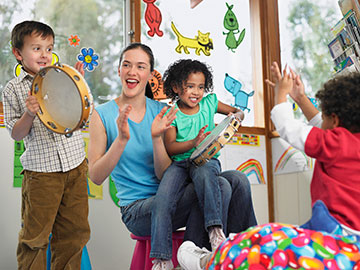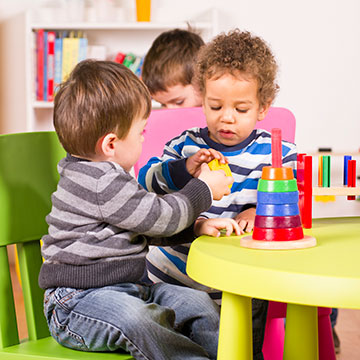
By Sam Batterman
At Seraphim, we love technology; but too often, it takes the front seat when process can be just as important. This article speaks to the importance of excellent procedures and process for the safety and security of your church’s children.
The modern church is marked by deep investments in children’s ministries.
Most families have a stake in this investment by either having children in these programs for many years, allowing their children to come (via a bus ministry) for multiple years, or having grandchildren in these ministries. Vacation Bible School is the preeminent investment in children’s lives in the summertime, with camp coming in a close second for older children.
Children’s ministries require an enormous amount of coordination, dollars, scheduling and facility management. Coordination of teaching materials and marshalling of snacks has the added complexity of worrying about new food allergies, diabetes and other medical scenarios.
This is just one of several great articles from the new eBook,
Reimagining Software. Download it for free on our website.
We add to these responsibilities the boom of technology which has impacted all children. How we tell a story or teach a lesson needs multimedia impact to reinforce the message of the Bible, in many cases. Flannel graph versus XBOX and Ultra-HD television is an unfair fight.
When it comes to children’s ministry, the biggest — and yet most subtle — changes in the last 20 years are security and safety. In the past, making sure kids weren’t hurt on the church’s playground equipment might have sufficed. Now, security and safety are marked with concerns over custody battles, pedophiles and other unknown predators.
Today, for a guest with children visiting your church, the idea of leaving those kids with strangers can be a frightening proposition.
- Who are these people? Have they been vetted in some way?
- How will they know how to get a hold of me quickly if my child needs me?
- How can I insure my child’s allergies and medical preferences are known and respected?
- How will I know my child hasn’t been taken by someone I don’t know before I get back to the classroom or nursery?
 There are numerous stories of visitors and guests leaving a church shortly after arrival, having surveyed the security of the nursery and classrooms and deciding that staying for worship services is as risky as losing their children in a crowded mall.
There are numerous stories of visitors and guests leaving a church shortly after arrival, having surveyed the security of the nursery and classrooms and deciding that staying for worship services is as risky as losing their children in a crowded mall.
Technology has matured to a place where every church can not only make this issue go away, but give guests peace of mind. So, they can pay more attention to the message.
Children are important to Jesus, and they should be important to us as church members. This includes every dimension of the children’s ministry.
7 key safety and security measures
1. Background checks for staff and volunteers. This is by far the most economical, easiest safeguard to put into place. There are many internet-based services that can do a quick search for a few dollars.
Many churches require the payment from the volunteer, so it’s essentially a service that costs the church nothing but gives back immense confidence regarding who’s in the rooms with children.
2. Badges. This is the most basic security feature which should be implemented in a church setting. A badge identifies the child, their parents’ or guardians’ names, allergies and medical information pertinent to a stay of any length. This allows teachers to call the child by name and engage them in the lesson and activities, while also respecting any food allergies (increasingly common) during snack time.
3. Access to children. This measure is largely overlooked in churches. Can just anyone at the church walk into a location that’s largely filled with children? How do you know who the parents are? How do you know about potential delegates who can safely pick up children after church and raging custody battles that can land you on the front page of your local newspaper? This is a difficult one to solve because many churches haven’t had the luxury of architecting the children’s area with fixed entry and egress traffic flow. For many churches, this is a continual challenge.
4. Diaper and bathroom duty. OK, this one is a little too obvious. Even so, every month, in nearly every city in America, there’s a news story about a child who was abused by a churchgoer. This point is more about removing the opportunity altogether for this to ever happen.
To avoid nearly any kind of improper situation, taking children to bathrooms and changing of diapers should be done by the female staff. You’ll need to determine the ages in which staff and helpers assist the children in the bathroom, rather than waiting outside the restroom for them. Perhaps a “rule of two staff” for each party to the bathroom is warranted, as well.
5. Authentication of parents to children. This is where technology comes in strongly. The ability to limit who can check a child into an event — and who that child can leave with — is strongly tied to the model of the family that you have for all the family members involved. Without a strong, central database, this important security measure fails or becomes so unwieldy that it loses its value.
Your church’s safe check-in processes need to be tightly integrated with your church management system. You need to understand who the family is, head and spousal roles, siblings, location and communication methods to reach parents in the event of a medical emergency.
There are numerous ways to handle authentication. For well-known members and regular attenders, names and phone numbers might suffice. For visitors and guests with little to no information in the database, you must be able to quickly enter and tie together information to form these family bonds before taking the children into the church’s responsibility. This is yet another reason the safe check-in features should be tightly integrated with your church management system.
6. Authorization. Authentication and authorization go hand in hand. Just because someone approaches you and asks for a child, doesn’t mean he or she is authorized by a family member to be with that child. This plays strongly to the family model (who the mom and dad are, who the siblings are, who other delegates are who are authorized to pick up children on behalf of the parents — namely, best friends and grandparents). In many cases, a security code is tied to the family unit and to the event of the child being checked in.
This is known as “Safe Check In”; it’s this step of insuring authentication and authorization that separates it from just having name badges on children.
Authorization can take many forms. It can be a security code that’s printed on a badge for the child, with a matching badge given to the parent at check-in. This security code is used to tie together the parent and child and has the added benefit of insuring the family model was verified at the point of check-in. This code can have various degrees of sophistication; generally, however, it should be unique to the family pairing and the event. (In other words, the code can’t be reused over and over again, week after week. This destroys the secure aspects of authentication.)
Many churches are moving away from alphabetic codes and toward symbolic codes — barcodes and QR codes, for example. While these codes usually garner a periodic reference to the book of Revelation (jokingly, in most cases), this represents a significant increase is security. Codes require additional investments in equipment. Barcodes and QR codes require scanning equipment: lasers and — in the case of QR Codes — cameras.
Badge printing is usually done with thermal printers, which are different than the laser and ink-jet printers most of us use. Thermal printers burn the images onto labels using lasers. Though they have the added advantage of not using ink cartridges, they’re also somewhat expensive.
Prices range based on quality and capabilities, but average cost usually falls between $250 and $350. Added to this would be barcode / QR scanners,which can fall into the same price range as a thermal printer.
Many churches try to reduce these label and printing costs by issuing keychain FOBs with barcodes unique to a family. These tags — similar to the loyalty cards we use at grocery stores — can save money on printer labels, but are generally limited to members and regular church attenders. Visitors, on the other hand, will likely require printed badges. Privacy concerns and invasion of privacy will be paramount in a guest’s mind, so don’t force them to do something they find uncomfortable. In this case, options are good.
7. Visual match-up. With all these codes, we’ve greatly beefed up security. One final way to increase security and peace of mind is with pictures of both the parents and the children in a family unit. If a parent were to drop his or her badge, a stranger could possibly use that code to be authenticated to the family unit. As such, a picture at the time of authentication / authorization is a great aid in making sure the child leaves with the right authorized adult.
These pictures can be difficult to get a hold of, and they serve a different function than the Facebook profile image of the family on vacation or a favorite pet. These photos are used to authenticate individuals during the check-in / check-out process, and therefore need to be clear and unambiguous — not the parent at a party with 16 other people in the photo, for instance.
Remember that photos of children under the age of 13 must be approved by parents, according to the Child Online Privacy and Protect Act, or COPPA.
Sunday morning only?
Some churches only do safe check-in during the most popular service — usually the morning worship service on Sunday (or Saturday, for some denominations). The argument goes something like this: Most guests come to our church during this time, so we want them to have a good experience.
The reality is that safe check-in — if you do it at all — should happen any time children are separated from their parents. Doing this just for guests sends the wrong message to members and regular attenders. Good security is a rigorous and vigilant process.
Remember: The measure of security success is if nothing happens — not in the stopping of something sinister.
Taking all these tenets and strategies into account, and then adding technology to make them rigorous and repeatable, is a good start.
Sam Batterman is the president and CTO of Seraphim Software, a cloud-based church management software company based in Collegeville, PA. Visit Batterman and his team at Going Digital in Washington (October 2014).
RELATED RESOURCES:
- Get (and keep) their attention — with software
- Seraphim — the next generation of church management and congregational engagement
- Geography matters!


